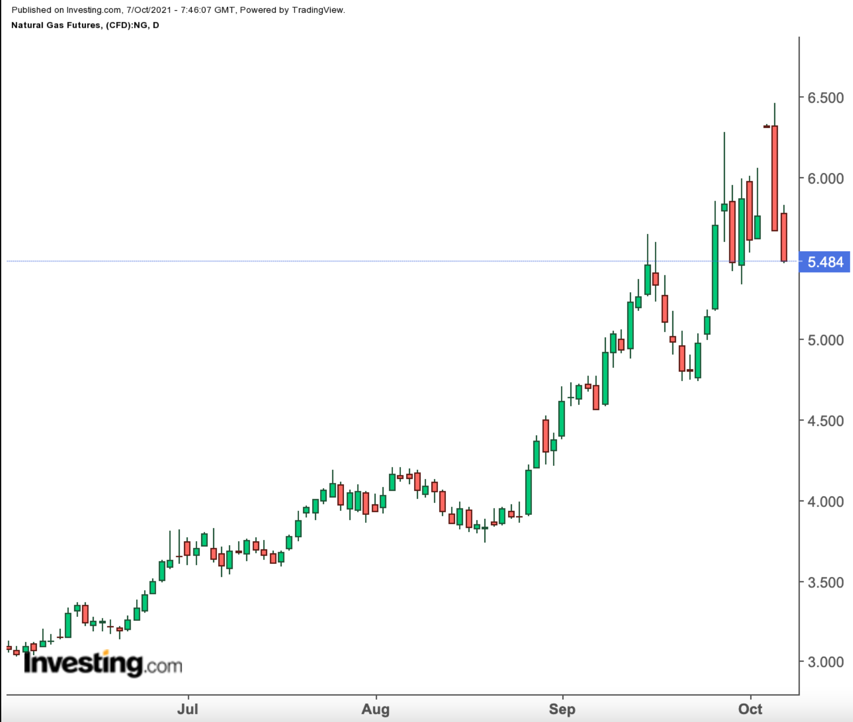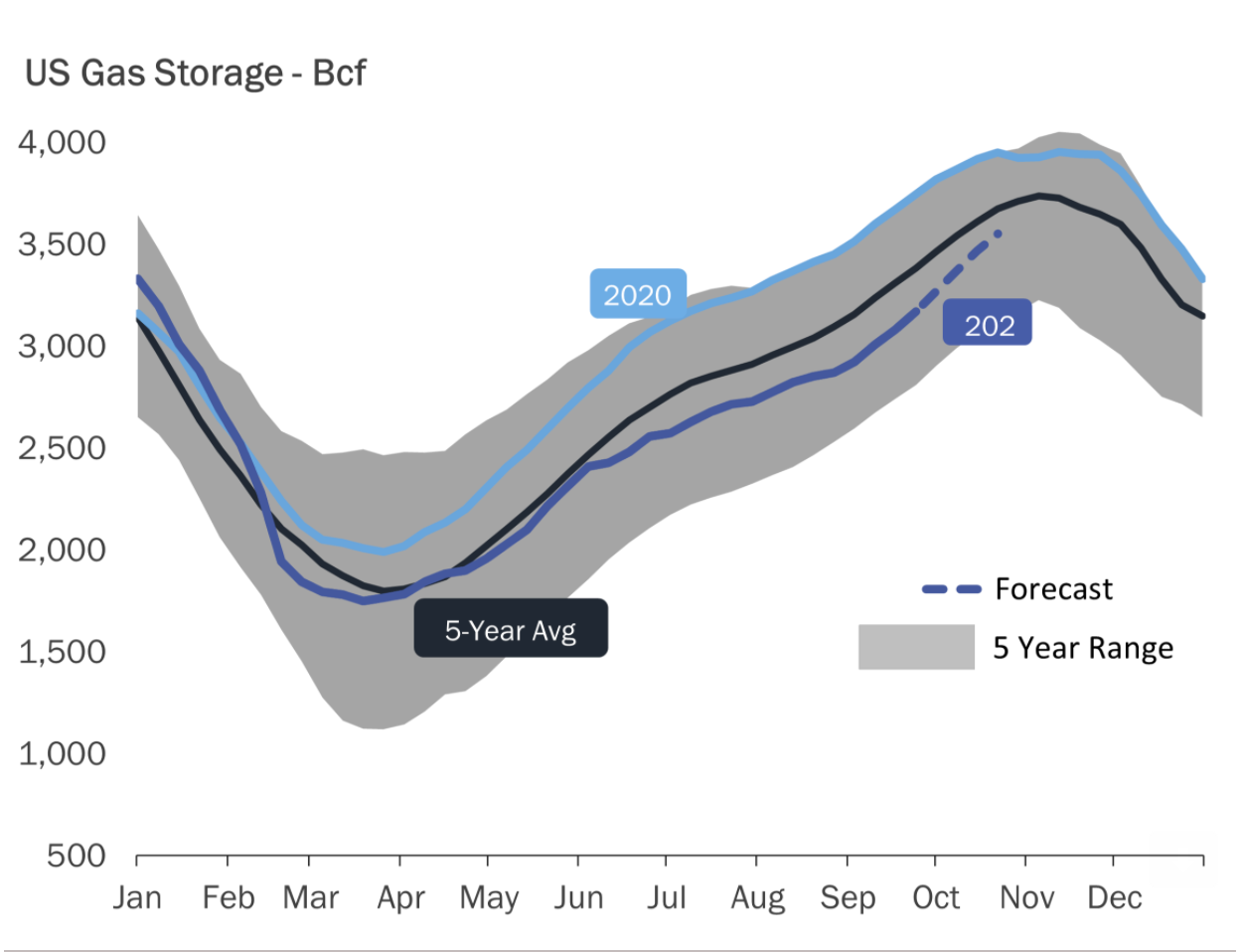Will the price of natural gas reach $7 as quickly as it got to the mid $6s?
It’ll depend on the relief Vladimir Putin can provide to Europe’s energy crisis; whether the sudden rough chart action in 'natty' becomes favorable to market bulls again; and whether there’ll be fewer triple-digit injections into US gas storage than forecast this cold season.

Gas got to a peak of $6.466 per million metric British thermal units on the New York Mercantile Exchange’s Henry Hub on Wednesday, before turning around and nosediving 10%, in a near perfect reversal of Tuesday’s market.
Stunned traders apportioned blame to Russian President Putin, technical indicators that didn’t support further momentum to the market’s upside, unseasonably balmy weather and a general wariness toward what could be the first storage build of above 100 billion cubic feet for this fall.
Putin yanked the cord first when he said Moscow could “reach another record” in gas deliveries in the coming winter to help heat a severely undersupplied Europe. This is despite criticism that Russia’s state-owned energy giant Gazprom (MCX:GAZP) (OTC:OGZPY) has been slow to increase gas shipments of late while Western European countries have been struggling to rebuild inventories stretched by minimal production during the coronavirus pandemic.
If Putin Eases Europe Gas Crisis, US Rally Could Lose A Leg
As the Wall Street Journal pointed out, flows of Russian gas to Europe have been subject to intense debate among energy traders and officials in recent months, and will play a key role in determining whether prices remain at economically punitive levels.
Higher prices are being interpreted in European capitals as an attempt to pressure officials and regulators into approving Nord Stream 2, a controversial pipeline linking Russia and Germany.
Further complicating matters is the sheer influence European energy prices have had in the rally in US natural gas. Benchmark Dutch gas futures rose as much as 40% in Wednesday’s morning trading, supercharging the run on NYMEX’s Henry Hub, before the US market’s turn. European gas buyers have also been clamoring for any cargo of US LNG, or liquefied natural gas, that they can land, further heightening the bullish state of the market in New York.
So, back to Putin and Europe’s gas crisis: If the Russian president does manage to bring measurable relief to the problem, European gas prices could calm significantly, removing one leg possibly to the runaway US gas rally.
Chart Action, Weather Not Exactly On Bulls’ Side
Next, chart action: Some technical factors may have played a role in Wednesday’s crash on the Henry Hub, says ICAP Technical Analysis’ Brian LaRose in a post carried by naturalgasintel.com.
The market “needed the $6.535 level breached to have confidence in an upside breakout,” LaRose said.
“Bulls could not get the job done.”
He said that with bears having arrived to “spoil the party,” now a “dump to $5.455-$5.453, even $4.875-$4.873 has the potential to unfold near term.” Henry Hub reached a low of $5.465 in Thursday’s Asian trading.
Weather is also doing its part to embolden bears. There hasn’t been much change in long-range weather forecasts, with “exceptionally light” US demand expected to continue.
NatGasWeather said the mild pattern includes highs over the eastern two-thirds of the US, mainly in the “comfortable” mid-60s to 80s and with very little coverage of highs of 50s or 90s. Cooler exceptions were expected to continue over the Northwest and Mountain West as Pacific systems bring much-needed valley rains and mountain snows.
The weather last week was milder-than-normal with 51 TDDs, or total degree days, compared with a 30-year average of 64 TDDs for the period.
TDDs, used to estimate demand to heat or cool homes and businesses, measure the number of degrees a day's average temperature is below or above 65 degrees Fahrenheit (18 degrees Celsius).
To stay their course on the market, gas bulls have tuned their minds into “late October … when more impressive cold fronts will attempt to sweep across the Midwest and East,” NatGasWeather said.

Source: Gelber & Associates
Is This Fall’s First Triple-Digit Build On Tap?
Last but not least, are forthcoming storage injections.
As the market awaits another weekly update on inventory levels due today at 10:30 AM ET (14:30 GMT), the US Energy Information Administration is expected to report that utilities in the country injected a bigger-than-normal 105 bcf, or billion cubic feet, into storage last week amid tepid weather.
That compared with a build of 75 bcf during the same week a year ago and a five-year (2016-2020) average increase of 81 bcf.
In the prior week to Sept. 24, utilities injected a bigger-than-normal 88 bcf of gas into storage. That was the second week in a row that utilities added more gas into inventories than usual.
“While triple-digit injections aren’t exactly unheard of for this time of year, they are somewhat rare,” said Daniel Myers, analyst at Houston-based gas markets’ consultancy Gelber & Associates.
“In the past, out of the last 26 years, only three have yielded 100+ injections for this particular week of storage.”
If forecasts are on target, the injection during the week ended Sept. 24 would take stockpiles to 3.275 tcf, or trillion cubic feet, some 5.5% below the five-year average and 14.3% below the same week a year ago.
Early estimates for the current week to Oct. 8 ranged from an addition of 73 bcf to 107 bcf, with a mean increase of 95 bcf, according to data provider Refinitiv.
That would compare with an injection of 50 bcf during the same week last year and a five-year average build of 79 bcf.
Disclaimer: Barani Krishnan uses a range of views outside his own to bring diversity to his analysis of any market. For neutrality, he sometimes presents contrarian views and market variables. He does not hold a position in the commodities and securities he writes about.
